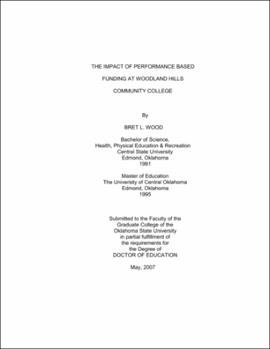| dc.contributor.advisor | Mathers, Judith | |
| dc.contributor.author | Wood, Bret L. | |
| dc.date.accessioned | 2013-11-26T08:35:02Z | |
| dc.date.available | 2013-11-26T08:35:02Z | |
| dc.date.issued | 2007-05 | |
| dc.identifier.uri | https://hdl.handle.net/11244/7636 | |
| dc.description.abstract | Scope and Method of Study: The purpose of this qualitative study was to examine the impact of performance based funding at Woodland Hills Community College since its implementation in 2001. Performance based funding was a new program to the State that rewards public higher education institutions for meeting or exceeding pre-defined performance criteria including retention and graduation rates. This case study focused on participant interviews, document analysis, and personal observations. Because Burke & Minassians (2003) contends the policy is invisible below the Vice President level, participant interviews included members of the Presidents Executive Council, as well as members of the Academic Council. | |
| dc.description.abstract | Findings and Conclusions: This study shows that performance based funding did have an impact on Woodland Hills Community College. It should be noted that all names have been changed in this study to provide anonymity to the participants and the institution involved. This includes pseudonym changes to citations and references listed in the bibliography. Specifically it had an impact on the programs and services the campus began implementing to assist students that comprised the first-time, full-time cohort, which is the reportable group to the State Regents for this funding policy. However, the policy did not permeate the culture of the campus. Instead, the policy became invisible at some point since it's inception in 2001 and a new definition of student success was created. Respondents spoke about this student success as they gave detailed information about the new programs, services and opportunities that enable the first-time, full-time student to remain at Woodland Hills Community College until graduation. However, this only represents 10% of the total student body on campus, and it has left questions about the programs, services and energy being spent on the remaining 90% of the students that are part-time, non-degree seeking, or transfer students. | |
| dc.format | application/pdf | |
| dc.language | en_US | |
| dc.rights | Copyright is held by the author who has granted the Oklahoma State University Library the non-exclusive right to share this material in its institutional repository. Contact Digital Library Services at lib-dls@okstate.edu or 405-744-9161 for the permission policy on the use, reproduction or distribution of this material. | |
| dc.title | Impact of performance based funding at Woodland Hills Community College | |
| dc.contributor.committeeMember | Harris, Ed | |
| dc.contributor.committeeMember | Carlozzi, Al | |
| dc.contributor.committeeMember | Mendez, Jesse | |
| osu.filename | Wood_okstate_0664D_2178.pdf | |
| osu.accesstype | Open Access | |
| dc.type.genre | Dissertation | |
| dc.type.material | Text | |
| thesis.degree.discipline | Teaching and Curriculum Leadership | |
| thesis.degree.grantor | Oklahoma State University | |
